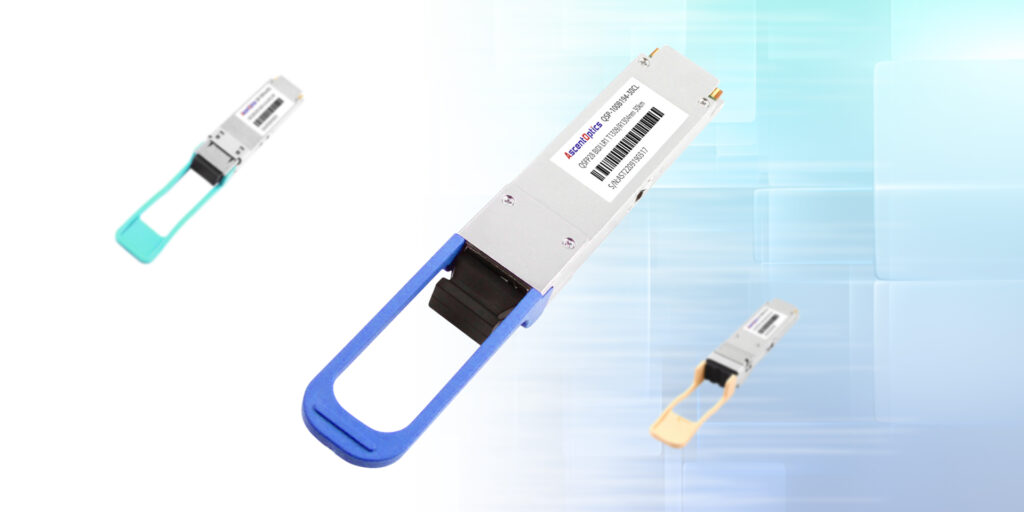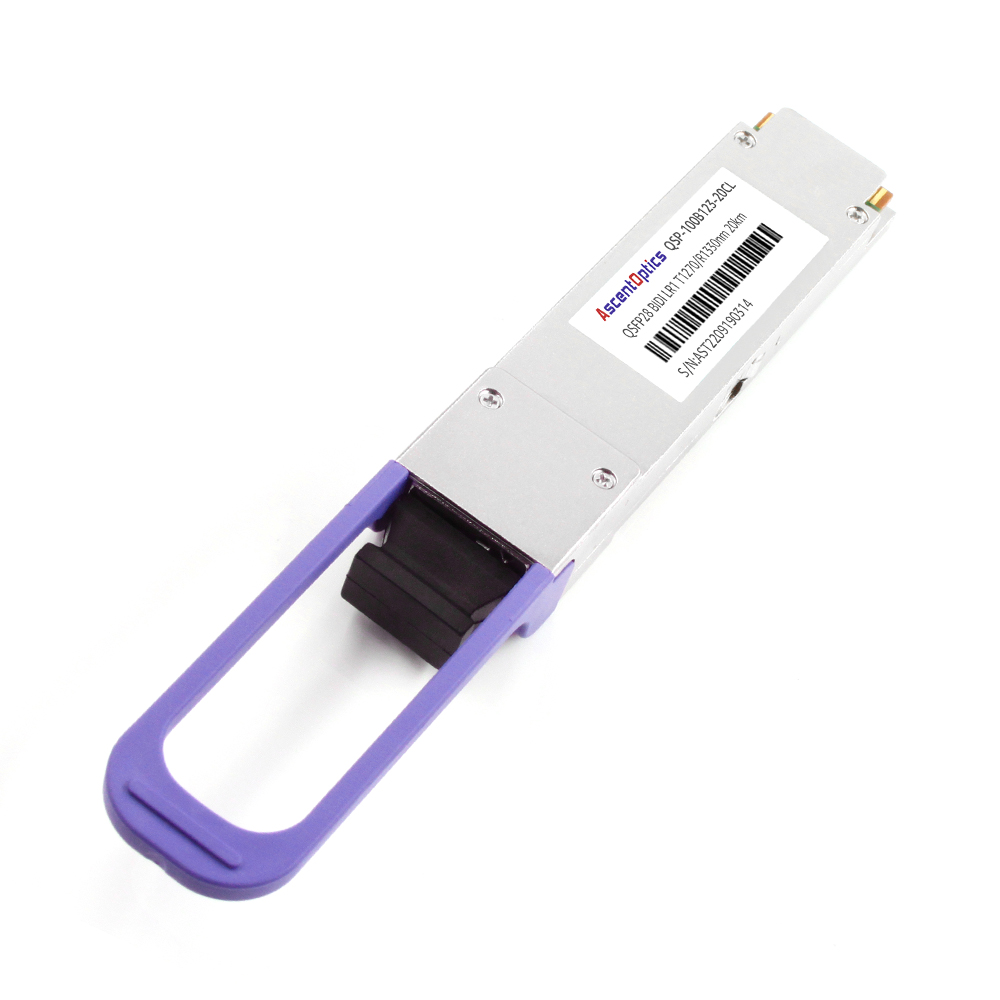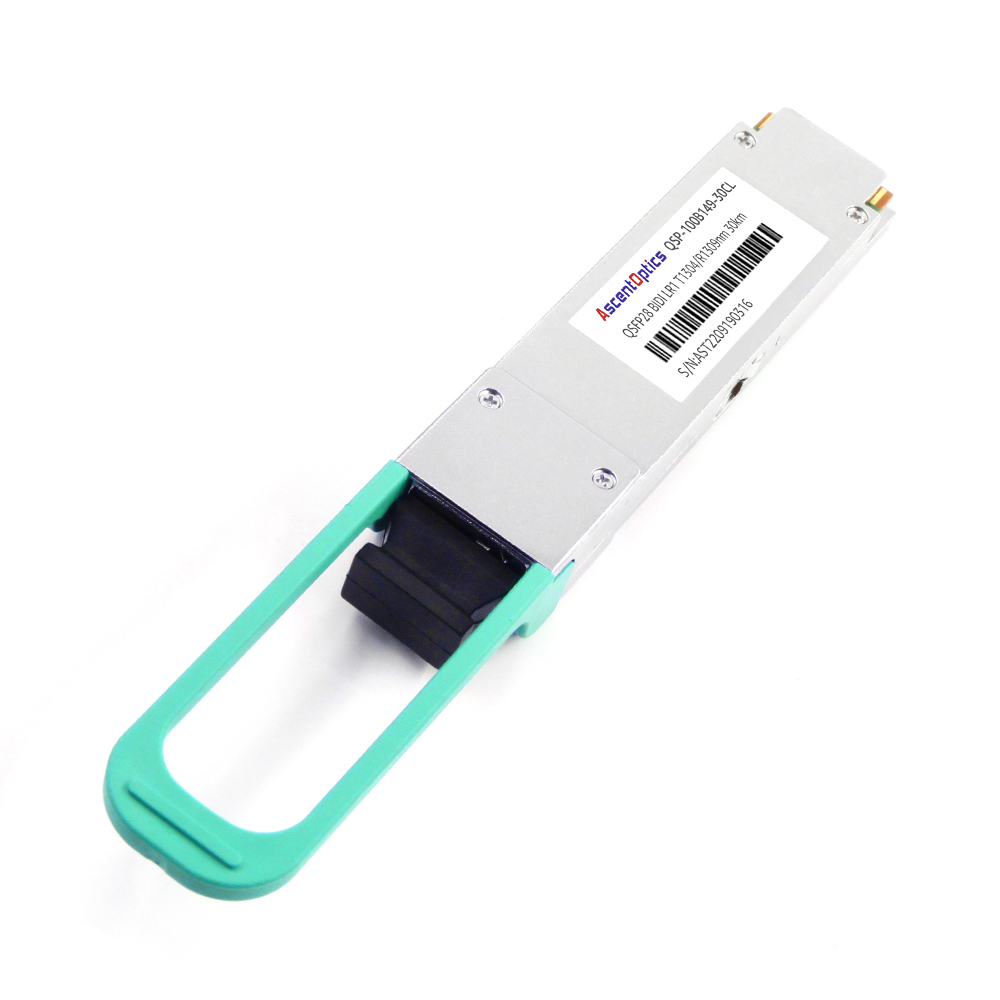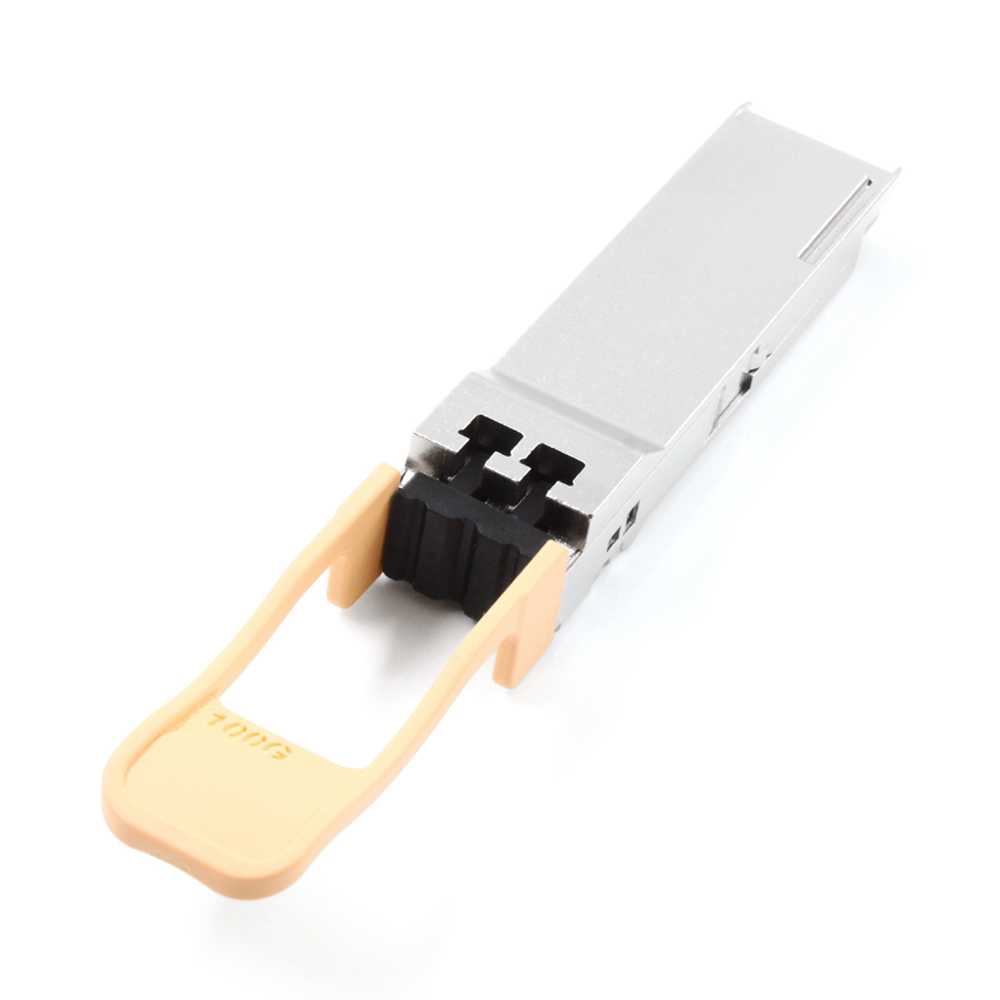
A 100G QSFP28 transceiver is a type of optical transceiver that operates at a data rate of 100 Gigabits per second (Gbps). QSFP28 stands for Quad Small Form-factor Pluggable 28 and refers to the form factor of the transceiver module. It is mainly used in data centers, high-performance computing networks, and other connectivity applications that require high-speed data transmission over fiber optic cables.
The 100G QSFP28 optical transceiver is a type of transceiver that supports a data rate of 100 Gbps over a single wavelength. It also supports protocols like Ethernet, Fibre Channel, InfiniBand, and SONET/SDH. The optical mode used in 100G QSFP28 transceivers can vary depending on the requirement of the network, such as short reach, long reach, or extended reach applications.
The 100G QSFP28 SR4 transceiver is designed for short-reach applications and supports transmission distances of up to 100 meters over multimode fiber using parallel optics. Four bidirectional lanes transmit up to 25 Gbps on each fiber pair. It is commonly used in data center applications, such as switch-to-switch connectivities and server-to-switch applications.
The 100G QSFP28 LR4 transceiver is designed for long-reach applications and supports transmission distances of up to 10 kilometers over single-mode fiber. It uses four channels that transmit at a data rate of 25 Gbps per channel. It is commonly used in telecommunications networks, metro networks, and data center interconnects.
The 100G QSFP28 PSM4 transceiver is designed for extended-reach applications and supports transmission distances of up to 2 kilometers over single-mode fiber. It uses four channels that transmit at a data rate of 25 Gbps per channel. It is commonly used in long-haul telecommunications networks, where the transmission distance is longer than what can be achieved with the LR4 transceiver.
In conclusion, using QSFP28 transceivers provides several benefits, such as high-speed data transmission, compatibility with multiple protocols, and support for different fiber types and transmission distances. The different variations of the QSFP28 transceiver, such as the SR4, LR4, and PSM4, offer other technical specifications and functional spaces to meet the requirements of other networking applications. Understanding the differences between each variation is crucial in selecting the suitable transceiver for a specific application.

When it comes to 100G QSFP28 transceivers, there are several types available on the market. This section will discuss each type in detail to help you better understand its unique features and benefits.
The 100G QSFP28 SR4 transceiver is a multimode optical module that operates on four lanes of OM4 or OM3 fiber with a link length of up to 100 meters. It uses a 4x25G electrical interface and is widely used in high-performance computing environments for short-reach data transmission.
The 100G QSFP28 LR4 transceiver is a single-mode optical module that operates on four fiber lanes with a link length of up to 10 kilometers. It uses a 4x25G electrical interface commonly used in telecommunications and data center applications for long-reach data transmission.
The 100G QSFP28 PSM4 transceiver is a parallel single-mode optical module that operates on four fiber lanes with a link length of up to 500 meters. It uses a 4x25G electrical interface and is ideal for intra-rack and inter-rack data center applications requiring higher density and lower power consumption.
The 100G QSFP28 ER4 transceiver is an extended-reach single-mode optical module that operates on four fiber lanes with a link length of up to 40 kilometers. It uses a 4x25G electrical interface and is mainly used in long-haul telecommunications applications where data transmission over long distances is required.
In conclusion, 100G QSFP28 transceivers are high-speed modules designed to transmit data over optical fibers with rates up to 100Gbps. They come in different types tailored to specific applications, such as short-range, long-range, and extended-reach transmissions. By understanding the different types of 100G QSFP28 transceivers, you can choose the right one for your specific needs and optimize your data transmission performance.
Recommended Products:100G QSFP28 2-Channels DWDM 80km Transceivers
Modern high-performance computing networks require high-speed connectivity to deliver smooth operations and enhanced user experience, making using 100G QSFP28 transceivers essential. These transceivers come in the quad small form-factor pluggable (QSFP28) form factor, which is compact and allows for more excellent network design and deployment flexibility.
The QSFP28 form factor results from technological advancements to increase data rate and functionality while reducing the size of connectivity devices. QSFP28 transceivers can provide high-speed connectivity in a compact form, allowing for greater port density and flexibility in network design. Additionally, QSFP28 transceivers offer greater cost-effectiveness as compared to other form factors.
The demand for high-speed data transmission has led to the popularity of 100G Ethernet – a standard for data transmission at 100 Gigabits per second. This high data rate enables faster data transfer, which is essential for applications requiring low latency and real-time data processing. Consequently, using 100G QSFP28 transceivers allows for faster data transmission and increased network performance.
Cisco has established itself as a leading provider of networking solutions globally. To ensure the highest level of quality, Cisco has set its compliance standards that network solutions must meet to be compatible with their devices. QSFP28 transceivers are Cisco compliant, meaning they meet Cisco’s rigorous standards and are guaranteed to work optimally with Cisco devices.
The Multi-Source Agreement (MSA) is an industry standard ensuring compatibility between manufacturers’ transceivers and other networking devices. By adhering to the MSA standard, QSFP28 transceivers are designed to function seamlessly with other devices from different manufacturers. This opens up possibilities for greater flexibility in network design and deployment.
High-performance computing (HPC) networks demand reliable and efficient interconnectivity between devices to enhance data processing speed. QSFP28 transceivers are designed to deliver faster, more reliable, and cost-effective interconnectivity in HPC networks. The advantages of QSFP28 transceivers include reduced latency, greater bandwidth, and more excellent network resilience, resulting in increased network performance.
In summary, 100G QSFP28 transceivers are essential for modern high-performance computing networks. Their compact QSFP28 form factor allows for greater flexibility in network design, while the 100G Ethernet standard provides faster data transmission. The fact that QSFP28 transceivers are Cisco-compliant and MSA-compliant means they can work seamlessly with other devices from different manufacturers, delivering more excellent compatibility. Ultimately, using QSFP28 transceivers results in high-speed connectivity, increased network performance, and enhanced user experience.

100G QSFP28 transceivers are popularly used in data center environments as an effective solution to streamline networking operations. The technology is implemented to replace the older 40G equipment with faster and more reliable 100G components. Modern data centers are heavily dependent on high-speed networking, and using the 100G QSFP28 transceivers provides many benefits, including increased speeds, better reliability, and scalability. The 100G QSFP28 transceivers are used for direct attachment to servers, switches, and routers and help data centers significantly reduce latency. Additionally, the technology improves energy efficiency and helps to simplify cabling and lower costs.
100G QSFP28 transceivers are also used to implement 100G Ethernet, which provides faster data transfer rates than ever before. This technology is critical for high-bandwidth data transmission, and the 100G QSFP28 transceivers are vital components in this system. As businesses and organizations look to scale their operations and stay ahead of the competition, it has become increasingly important to have networks that can quickly and reliably handle vast amounts of data. The 100G QSFP28 transceivers solve these high-speed data transfer requirements.
For long-distance networking applications, 100G QSFP28 transceivers are utilized with single-mode fiber. The technology provides vital benefits for telecommunications, service providers, and government entities requiring robust networks to securely transmit data over long distances. These transceivers can transmit data over distances up to 40 km and operate at distances up to 80 km. They are also designed for use in areas often exposed to harsh environmental conditions, such as high temperatures and dust. As more organizations rely on long-distance networks, using 100G QSFP28 transceivers with single-mode fiber will only continue to grow.
For networks covering up to 100 m distances, 100G QSFP28 transceivers are used with multimode fiber. These transceivers provide high-bandwidth connections for data centers, enterprise networks, and other applications. The technology is also cost-effective and offers improved reliability compared to older models. 100G QSFP28 transceivers are the ideal solution for network architectures that require high-speed connections between backbone switches and servers.
Finally, 100G QSFP28 transceivers are used in CWDW4 and SR4 solutions for data centers and enterprise networks. The CWDW4 solution is used for single-mode fiber optic cables, while SR4 is used for multimode fiber cables. Both solutions provide reliable, high-speed connectivity and are ideal for use in data centers and enterprise networks where fast and reliable data transfer is essential. Using 100G QSFP28 transceivers in these solutions offers users significant bandwidth improvements, more efficient use of physical space, and reduced power consumption.
In conclusion, the applications of 100G QSFP28 transceivers are wide-ranging and include use in data centers, 100G Ethernet, single-mode fiber, and multimode fiber. The technology provides users faster and more efficient data transfer rates, improved reliability, and scalability. As organizations continue to rely more heavily on high-performance networks to support their operations, the use of 100G QSFP28 transceivers will only continue to grow.

As data centers strive to keep pace with the relentless growth in data communication traffic, 100G QSFP28 transceivers have emerged as a popular choice for high-speed connectivity. The 100G QSFP28 transceiver is a pluggable fiber optic module that supports blazing-fast data rates of up to 100 Gbps. This article discusses the critical factors to consider when choosing a 100G QSFP28 transceiver.
Form Factor:
The form factor refers to the transceiver’s size, shape, and electrical interface. QSFP28 transceivers come with various form factors, including SR4, CWDM, LR4, PSM4, and CLR4. While the form factor is not an essential consideration, it is crucial to determine the form factor compatibility with your network equipment. Not all network devices support all form factors, so scale carefully to avoid wastage of network investments by overlooking compatibility.
Connectivity:
The connectivity of the 100G QSFP28 transceiver determines whether the transceiver can connect to the correct port on your network device. Identify the port on your device and check if your transceiver matches its connectivity type. QSFP28 transceivers come with fiber and copper interfaces; some even support InfiniBand connectivity. Consider the type of cabling that your network uses and choose a transceiver that matches the suitable connector. Some popular connector types include LC, MPO, and copper QSFP.
Wavelength and Duplex:
The wavelength and duplex settings of the transceiver dictate the distances over which it operates. Typically, the 100G QSFP28 transceiver operates over single-mode, multi-mode, or copper cabling. The multiplexing method also affects the wavelength – choose between WDM or CWDM. The WDM method uses wavelengths between 1271-1331 nm, while the CWDM method supports wavelengths over a more extensive range. Be sure to choose the correct wavelength and duplex settings for the distance requirements of your use case.
MSA Compliance:
Multi-source agreement (MSA) compliance ensures interoperability and compatibility between the 100G QSFP28 transceiver and other network devices. MSAs provide a standardized interface between network devices and transceivers, allowing plug-and-play functionality. Ensure that the transceiver complies with the appropriate MSA, such as the QSFP28 MSA, which ensures the transceiver, port, and cable compatibility.
IEEE Compliance:
IEEE compliance is another crucial factor when choosing a 100G QSFP28 transceiver. IEEE specifications dictate the electrical and optical performance of the transceiver and ensure that they operate within safety limits. The critical IEEE specifications include IEEE 802.3bj, IEEE 802.3bm, and IEEE 802.3 Ethernet standards. Ensure the 100G QSFP28 transceiver meets all the necessary IEEE safety regulations to avoid network problems and failures.
In conclusion, choosing the 100G QSFP28 transceiver is critical for any data center. Form factor, connectivity, wavelength and duplex, MSA compliance, and IEEE compliance are all vital factors to consider when deciding on the correct 100G QSFP28 transceiver. Consider these factors carefully to avoid compatibility issues and ensure the hassle-free performance of your network.
A: 100G QSFP28 transceivers are high-speed optical transceiver modules that offer a data transfer rate of up to 100Gbps and are used in data centers and high-performance computing networks for fast and reliable connectivity.
A: The QSFP28 MSA (Multi-Source Agreement) is a standard set of specifications that defines the mechanical, electrical, and optical characteristics of the QSFP28 transceiver form factor.
A: The maximum transmission distance for 100G QSFP28 transceivers depends on the type of the transceiver. The maximum transmission distance for 100G QSFP28 SR4 transceivers is 100m over OM4 MMF (Optical Multimode Fiber) and 70m over OM3 MMF, while the maximum transmission distance for 100G QSFP28 LR4 transceivers is up to 10km over single-mode fiber.
A: The different types of 100G QSFP28 transceivers include SR4 (Short Range 4-channel), LR4 (Long Range 4-channel), PSM4 (Parallel Single Mode 4-channel), CWDM4 (Coarse Wavelength Division Multiplexing 4-channel), ER4 (Extended Range 4-channel), ZR4 (Zero Dispersion Shifted Fiber Range 4-channel), BiDi (Bidirectional), and SWDM4 (Short Wavelength Division Multiplexing 4-channel).
A: The IEEE 802.3bm standard is a specification that defines the physical media dependent (PMD) layer specifications for 100G Ethernet links over optical fiber and supports various 100G QSFP28 transceiver types.
A: The form factor of 100G QSFP28 transceivers is QSFP28, a smaller and denser form factor than the earlier QSFP form factor.
A: The advantage of using 100G QSFP28 transceivers is that they offer high data transfer rates, reduce power consumption, and provide higher port density, which makes them suitable for high-performance computing networks and data centers.
A: There is no difference between 100G QSFP28 SR4 and 100G QSFP28 SR4 compatible transceivers. The compatible transceiver is designed to be fully compatible and interchangeable with the specified 100G QSFP28 SR4 transceiver type.
A: The optical signal modulation format used by 100G DWDM QSFP28 PAM4 transceivers is PAM4 (Pulse Amplitude Modulation 4-level) which uses 4-level coding to transmit twice the data rate of traditional 100G non-return-to-zero (NRZ) modulation format.
A: The role of CDR (Clock and Data Recovery) in 100G QSFP28 transceivers is to recover the clock signal from the incoming data signal and provide a stable and accurate clock signal to the output data signal, which helps to maintain the data integrity and reduce errors.